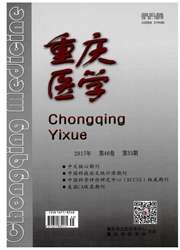

 中文摘要:
中文摘要:
目的研究正常中老年女性椎后肌群增龄退变与体质量指数(BMI)的相关关系:方法将115例48~75岁[平均(58.6±7.3)岁]的女性分为中年组(〈60岁)及老年组(≥60岁),使用定量CT(QCT)分别测量其L3椎体中部层面椎后肌群的肌肉面积及脂肪面积,计算肌肉脂肪浸润程度(MFI),即脂肪面积/(肌肉面积+脂肪面积)×100%。用独立样本t检验比较两组间的差异;采用相关及线性回归分析研究椎后肌群的肌肉面积、脂肪面积及MFI与年龄及BMI的关系。结果两组间BMI差异无统计学意义(t=-0.190,P=0.850),而椎后肌群的肌肉面积、脂肪面积及MFI差异均有统计学意义(t=2.182、-1.997、-2.604,P=0.031、0.048、0.010);相关及回归分析显示,控制身高、体质量因素,年龄与椎后肌群的脂肪面积及MFI呈正相关(r=0.275、0.320,t=2.915、3.445,P=0.004、0.001),而与肌肉面积无相关(t=-1.109,P=0.270);控制年龄因素,BMI与椎后肌群的脂肪面积及MFI呈正相关(r=0.361、0.307,t=3.945、3.277,P≤0.001),而与肌肉面积无相关(t=1.653,P=0.101)。结论正常中老年女性椎后肌群的脂肪含量随年龄增大而增加;评估其退变时,尤其是体质量大者,相对于肌肉面积,肌肉的脂肪含量及其比例更具意义。
 英文摘要:
英文摘要:
Objective To explore the correlation between the posterior vertebral muscle group aging degeneration and body mass index (BMI) in normal middle-aged and elderly women. Methods One hundred and fifteen women(48-75 years old) were divided into the middle-aged group (〈60 years old) and elderly group (≥60 years old). The muscle area of posterior vertebral muscle group and fat area at lumbar levels L3 were measured by quantitative computed tomography (QCT). The muscle fat infiltration (MFI) ,e. g. fat area/(muscle area + fat area) ,was calculated. The differences between the two groups were compared by using independent-samples t test. The correlation and linear regression analysis were used for analyzing the correlations between the muscle area,fat area and MFI with age and BMI. Results The BMI had no statistical difference between the two groups (P〈0. 05) ,while the muscle area of posterior vertebral muscle group, fat area and MFI had statistical difference(t = 2. 182,-1. 997,-2. 604, P 0. 031,0. 048,0.010)ithe correlation and linear regression analysis showed that controlling the body height, body mass factor and age were positively correlated with the fat area of posterior vertebral muscle group and MFI(r=0. 275,0. 320, t= 2. 915,3. 445, P= 0.004,0. 001), while had no obvious correlation with the muscle area(r=-1. 109, P = 0. 270) ;controlling age factor and BMI were positively correlated with the fat area of posterior vertebral muscle group and MFI(r=0. 361,0. 307,t=3. 945,3. 277,P〈0. 001), while had no obvious correlation with the muscle area(t = 1.653, P = 0.10 t). Conclusion In middle-aged and elderly women, the fat content of posterior vertebral muscle group is increased with the age increase. In evaluating the degeneration, especially greater body mass,the fat content of muscles and their proportion have more significance than the muscle area.
 同期刊论文项目
同期刊论文项目
 同项目期刊论文
同项目期刊论文
 期刊信息
期刊信息
